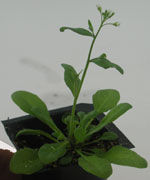
By Catherine Zandonella, Media Relations
In a major step for plant biology and agricultural science, scientists have completed the sequencing of the first plant genome, that of a mustard weed known as Arabidopsis thalania. The announcement, published Thursday, Dec. 14, in the journal Nature, marks the completion of a five-year effort that included key contributions from plant molecular biologist Athanasios Theologis, an adjunct professor in the Department of Plant & Microbial Biology at the University of California, Berkeley, and a senior scientist at the UC Berkeley/USDA Agricultural Research Service Plant Gene Expression Center in Albany, Calif.
Commonly known as mouse-ear cress or thale cress, Arabidopsis thaliana serves as a model genetic organism for research aimed at producing healthier food that is easier to grow. Arabidopsis thaliana is favored by researchers because it has a relatively small genome with only five chromosomes and roughly 25,000 genes - a third the amount of DNA found in rice. Completion of the genome will give scientists a road map to the genes involved in a plant's ability to live through drought, fight off disease and avoid predators.
Together with three collaborating institutes, Theologis and his team of 15 researchers deciphered the genetic sequence of the largest of the five chromosomes, Chromosome 1, which represents a quarter of the entire genome. Other members of the consortium to sequence Chromosome 1 include the Stanford Genome Technology Center led by Ronald Davis, the Arabidopsis thaliana Genome Center at the University of Pennsylvania led by Joseph Ecker (now at the Salk Institute in La Jolla, Calif.) and The Institute for Genomic Research in Rockville, Md., led by Claire Fraser. The four groups were part of an international Arabidopsis genome sequencing effort known as the Arabidopsis Genome Initiative (AGI), composed of laboratories from the United States, the European Union and Japan. The U.S. portion of the project was funded by the National Science Foundation.
